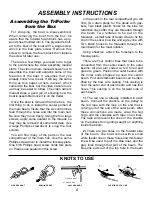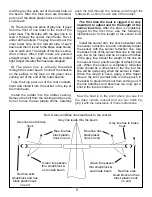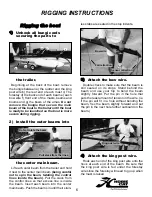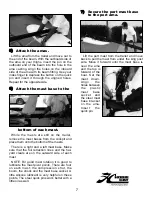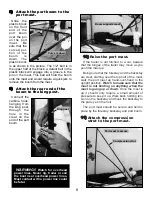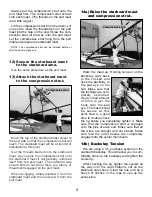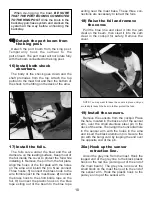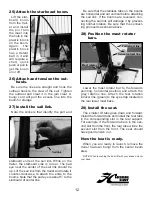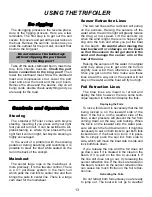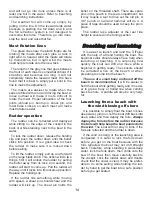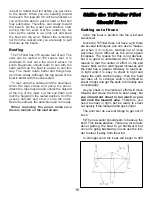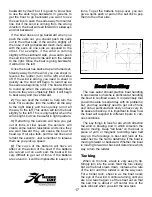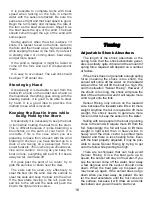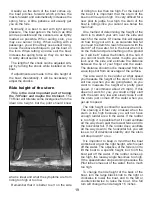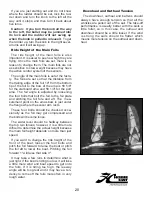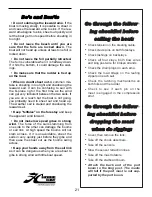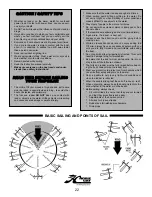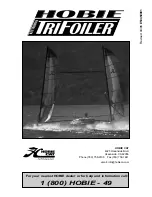
It is possible to complete tacks with boat
speed when tacking on the foils in smooth
water with the sensors retracted. Be sure the
sails are set right and that boat speed is good.
Begin the turn slowly and increase the rate of
the turn as the boat slows down. Sheet in as
the boat nears the eye of the wind. The boat
should come through the eye of the wind with
some speed.
Sailing upwind, when the wind is above 13
knots, it is fastest to sail on the foils. Get onto
the foils and then head up as high as possible
while keeping the boat on the foils. If you feel it
is slowing down or coming down, bear away
and get more speed.
If the wind is marginal, it might be faster to
come off the foils and sail in displacement
mode.
It is easy to over-sheet. The sail link should
be about 1' off center line.
Steering by Hand
Occasionally it is desirable to sail from the
back with a hand on the rudder and a hand on
the mainsheet. If anything goes wrong with the
steering pedals, it is good to be able to steer
by hand. It is a good idea to practice this
method to see what is involved.
Keeping the Boat in Irons while
being Held by the Stern
Occasionally it is necessary to keep the boat
in irons while holding the boat from the stern.
This is difficult because it is like balancing a
broomstick on the palm of your hand. It is
unstable. This is the case when you are
preparing to leave from a beach with the wind
blowing on shore or you have backed up to a
dock or are taking on a passenger from a
power boat etc.
This is where you should exer-
cise some caution.
As long as you keep the
boat in irons, everything will be OK. If it bears
away too far, it will take off.
If it goes past the point of no return, try to
grab the sail clew or boom near the clew.
The sails can be used very effectively to
steer the bow into the wind. Use the sail link to
steer the sails and keep the bow into the wind.
If the bow starts moving to the left, push the
sail link to the left and the sails will push the
bow to the right and vice versa.
18
Tuning
Adjustable Shock Absorbers
The length of the shock absorbers or the
spring force that the shock absorbers gener-
ates is actually quite critical and the amount of
spring force required will depend on a number
of factors.
If the shock does not generate enough spring
force (meaning the shock is too short), the
sensor will come off the water on the leeward
side and the foil will lift the boat too high. We
call this situation “Sensor Rising”. However, if
the shock is too long, the shock will press the
bow of the ama too low and it will require more
wind to get onto the foils.
Sensor Rising only occurs on the leeward
side, because the leeward side lifts a lot more
weight. Anytime the foil is required to lift more
weight, the shock needs to generate more
force in order to keep the sensor on the water.
Sailing with two people in the boat or pointing
close to the wind will require more lift from the
foil. Surprisingly, the foil will have to lift more
weight in light wind than in heavy wind. In
heavy wind the drive vector is pointed more
forward and there is less heeling force. Even
with the boat properly adjusted, it may be pos-
sible to cause Sensor Rising by trying to get
onto the foils while pointing too high.
There are techniques that can help avoid
Sensor Rising. Once the boat gets up to
speed, the sensor will stay on the water. If you
see the sensor come off the water, bear away
a few degrees and the sensor should come
down. When the boat gets up to speed, you
may head up again. If the sensor does not go
down when you bear away, be patient. Do not
let the boat accelerate until the foil comes to
the surface, because it will draw air and sink
back down and you will have to start over.
Summary of Contents for TriFoiler
Page 1: ...ASSEMBLY MANUAL...

